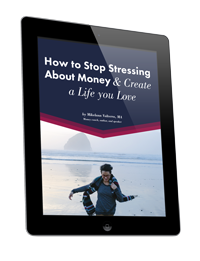Are you earning what you’re really worth? Do you make enough money to live the life that you desire? Or are you “underearning”—consistently making less money then you feel you should or want to be making?
Let’s look at some typical examples of underearning. Many people don’t earn their worth because they do not negotiate their initial salary (men negotiate their salary four times as often as women, by the way! Women more often just take what they are offered….) Some people underearn because they go too many years without asking for a raise. If they are self-employed, they often wait too long to raise their fees. I’ve also noticed that many people who are self-employed set their initial fees too low to begin with.
But there are numerous other ways to underearn. Some underearn by giving their time away in many different guises. Judy, an executive coach, found that she was volunteering excessively for her children’s activities and her church. She was so burned out with her numerous commitments that she didn’t have the time or energy to put into marketing her business. Please don’t misunderstand me. Volunteering is wonderful. But we must ask ourselves, is volunteering in any way hurting our ability to take care of ourselves financially?
Even those who work for a company must “market” themselves in order to earn what they’re worth. You must make sure you are noticed and appreciated for the work you do, so you will be given serious consideration around raise and promotion time. Allowing yourself to be invisible in the workplace may be comfortable, but it is a surefire way to underearn. Mary, an account executive, worked very hard but was often resentful when her less talented co-workers rose about her. She didn’t feel she could “toot her own horn”, but quiet people can be perceived as indecisive, or worst, just not noticed, as Mary discovered time and time again.
Others underearn by chronically underbilling for their services. Kristine, an architect, wanted her clients to feel they were getting a “good deal”. So she consistently billed them for fewer hours then she put in on a job. Sometimes she justified this by telling herself that she should have been able to do more in less time.
The ways that we can underearn are endless. But perhaps the “best” way to underearn is to not know how much you actually need to earn to live your life in the way that you desire. Many people are in a money fog and are unclear about exactly what they spend, and hence what they need to earn. Coming out of the money fog often leads people to re-evaluate their relationship to work and look deeply at what they are earning. (Recently, Karen McCall, the founder of the Financial Recovery Institute, did a four part series in her blog on the subject of “Is your work working for you”? She shares three stories of people who healed their relationship to work and earning money.)
The bottom line is that those who struggle with “underearning” often don’t get paid as much as might be expected, given their education, talents and experience. Underearning is about a pattern. We all go through periods of not making good money, through job setbacks, life circumstances, or the economy. But underearning is about a chronic—often lifelong—behavior. It occurs when you repeatedly undersell yourself.
Keep in mind that underearning is NOT about underachieving. Underearners can achieve great things and be highly respected by their colleagues, and still not be adequately compensated for their work. Another misconception is that underearners simply don’t work enough; again, the opposite is more likely to be true. Underearners are typically intelligent, hardworking people. In fact, many may be putting in long hours at the office, trying to get ahead. Yet, despite their dedication, the pay they receive is not commensurate with their time and effort.
I would encourage you to look back on through your work life and see if you can pinpoint different times you underearned. The beginning of dealing with the pattern of earning less than you need is recognizing it. When you become aware of times throughout your life you’ve undersold yourself, you begin to break denial around the part you play in making less money then you could. The next step is getting clear about how much you need to earn to life the life you deserve and desire.
TIME TO EARN MORE?
If you would like to earn what you’re truly worth and step into greater abundance, please see Mikelann’s Unlock Your Earning Power toolkit. Identify what has been holding you back, learn the skills to ask for more and start earning at your true potential. For both self-employed and salaried women.


